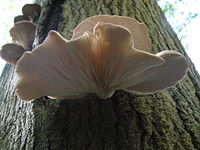
Photo from wikipedia
This review summarises the current state of knowledge on the biodegradation and fate of the gasoline ether oxygenate ethyl tert-butyl ether (ETBE) in soil and groundwater. Microorganisms have been identified… Click to show full abstract
This review summarises the current state of knowledge on the biodegradation and fate of the gasoline ether oxygenate ethyl tert-butyl ether (ETBE) in soil and groundwater. Microorganisms have been identified in soil and groundwater with the ability to degrade ETBE aerobically as a carbon and energy source, or via cometabolism using alkanes as growth substrates. Aerobic biodegradation of ETBE initially occurs via hydroxylation of the ethoxy carbon by a monooxygenase enzyme, with subsequent formation of intermediates which include acetaldehyde, tert-butyl acetate (TBAc), tert-butyl alcohol (TBA), 2-hydroxy-2-methyl-1-propanol (MHP) and 2-hydroxyisobutyric acid (2-HIBA). Slow cell growth and low biomass yields on ETBE are believed to result from the ether structure and slow degradation kinetics, with potential limitations on ETBE metabolism. Genes known to facilitate transformation of ETBE include ethB (within the ethRABCD cluster), encoding a cytochrome P450 monooxygenase, and alkB-encoding alkane hydroxylases. Other genes have been identified in microorganisms but their activity and specificity towards ETBE remains poorly characterised. Microorganisms and pathways supporting anaerobic biodegradation of ETBE have not been identified, although this potential has been demonstrated in limited field and laboratory studies. The presence of co-contaminants (other ether oxygenates, hydrocarbons and organic compounds) in soil and groundwater may limit aerobic biodegradation of ETBE by preferential metabolism and consumption of available dissolved oxygen or enhance ETBE biodegradation through cometabolism. Both ETBE-degrading microorganisms and alkane-oxidising bacteria have been characterised, with potential for use in bioaugmentation and biostimulation of ETBE degradation in groundwater.
Journal Title: Journal of hazardous materials
Year Published: 2020
Link to full text (if available)
Share on Social Media: Sign Up to like & get
recommendations!